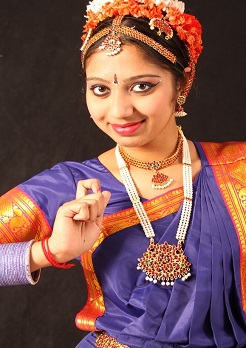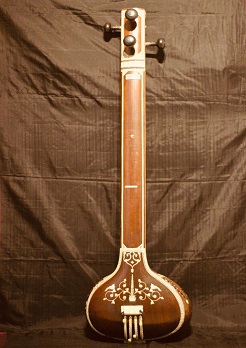Trainings
Schulungen
Art Forms
Kunstformen
Bharathanatyam
Bharathanatyam is a south indian temple dance, which is a combination aus Bhava (Expression), Raga (Tune), Tala (Rhythm) and Natyam (Drama). It is an art form, which shows the indian mythology in a dance. There are three different types in Bharatanatyam. Nritta: These are pure Rythmic dances without any explanation and expression. It has a lot of Jathis and Korvais, which are a combination of adavus. As example for these Nritta items are: Alaripu, Jathiswaram and Thillana Nritya: It is a dance type, which contains experssion and rhythm. In Nritya items the dancer performs different stories of the indian mytholoy. As an example for Nritya Items are: Pathams, Kautwams and Varnam Natya: Natyam mostly are showed as dance dramas. The facial expression and the gestures are very important in the Natya type. The dancer explains with the eyes and the body a complete story.
Bharathanatyam ist ein südindischer Tempeltanz, der eine Kombination aus Bhava (Ausdruck), Raga (Melodie), Tala (Rhythmus) und Natyam (Drama) darstellt. Es ist eine Kunstform, die die indische Mythologie in einem Tanz zeigt. Dort sind drei verschiedene Arten in Bharatanatyam. Nritta: Dies sind reine rhythmische Tänze ohne Erklärung und Ausdruck. Es gibt viele Jathis und Korvais, die eine Kombination aus Adavus sind. Als Beispiel für diese Nritta-Artikel sind: Alaripu, Jathiswaram und Thillana Nritya: Es ist ein Tanztyp, der Expersion und Rhythmus enthält. In Nritya-Stücken spielt der Tänzer verschiedene Geschichten des indischen Mythos. Als Beispiel für Nritya Items sind: Pathams, Kautwams und Varnam Natya: Natyam werden meist als Tanzdramen gezeigt. Der Gesichtsausdruck und die Gesten sind beim Natya-Typ sehr wichtig. Der Tänzer erklärt mit den Augen und dem Körper eine komplette Geschichte.

Bollywood dance
Bollywood dance is modern dance form in India, which is known from the movies. This dance is mostly a combination of indian folk dances, hip hop and oriental dance. The songs have Rhythmic beats and a catchy tune.The dancing in Bollywood films is primarily modelled on Indian dance: Classical dance styles, dances of historic northern Indian courtesans or folk dances. In modern films, Indian dance elements often blend with Western dance styles. Its usual to see Western pop and pure classical dance numbers side by side in the same film. The characters often perform with a troup of supporting dancers. If the characters dance and sing a pas-de-deux (a dance and ballet term, meaning "dance of two"), it is often staged in beautiful natural surroundings or architecturally grand settings. This staging is referred to as a "picturisation".
Bollywood-Tanz ist in Indien eine moderne Tanzform, die aus den Filmen bekannt ist. Dieser Tanz ist meist eine Kombination aus indischen Volkstänzen, Hip Hop und orientalischem Tanz. Die Songs haben rhythmische Beats und einen Ohrwurm. Das Tanzen In Bollywood-Filmen orientiert sich der Film hauptsächlich am indischen Tanz: Klassische Tanzstile, Tänze historischer nordindischer Kurtisanen oder Volkstänze. In modernen Filmen mischen sich indische Tanzelemente oft mit westlichen Tanzstilen. Es ist üblich, westlichen Pop und reine klassische Tanznummern im selben Film nebeneinander zu sehen. Die Charaktere treten oft mit einer Truppe unterstützender Tänzer auf. Wenn die Charaktere tanzen und ein Pas-de-Deux singen (ein Tanz und Ballettbegriff, was "Tanz von zwei" bedeutet), wird oft in einer wunderschönen natürlichen Umgebung oder in architektonisch großartigen Umgebungen aufgeführt. Diese Inszenierung wird als "Bildgebung" bezeichnet.

Carnatic Music
Carnatic music has been known as a spiritual and devotional art form, and has existed for several thousand years, predominantly in the south of india and travelled across the world from there. It was glorified in the era of the trinity (Thygaraja, Shyama Sastri and Dikshithar) who left us with a wealth of knowledge and musical compositions, what we practice till date as Carnatic music. Other noteworthy composers and gurus have shaped the art form throughout its history and exemplified its practice and essence for everyday learners. Carnatic music is known for it’s meditative benefits, as well as in medicinal and therepautic value. Each Raga elicits a particular emotion and mood, or is sung for a specific auspicious occasion (such as marriage, festivities) to invoke the presence and blessings of the divine.
Karnatische Musik ist als spirituelle und hingebungsvolle Kunstform bekannt und existiert seit mehreren tausend Jahren, hauptsächlich im Süden Indiens, und ist von dort aus um die Welt gereist. Es wurde in der Ära verherrlicht der Dreifaltigkeit (Thygaraja, Shyama Sastri und Dikshithar), die uns eine Fülle von Kenntnissen und musikalischen Kompositionen hinterlassen hat, was wir bis heute als karnatische Musik praktizieren. Andere bemerkenswerte Komponisten und Gurus haben geformt Die Kunstform im Laufe ihrer Geschichte und beispielhaft für ihre Praxis und Essenz für alltägliche Lernende. Karnatische Musik ist bekannt für ihre meditativen Vorteile sowie für ihren medizinischen und therapeutischen Wert. Jeder Raga löst aus eine bestimmte Emotion und Stimmung oder wird für einen bestimmten günstigen Anlass (wie Heirat, Feste) gesungen, um die Gegenwart und den Segen des Göttlichen hervorzurufen.
